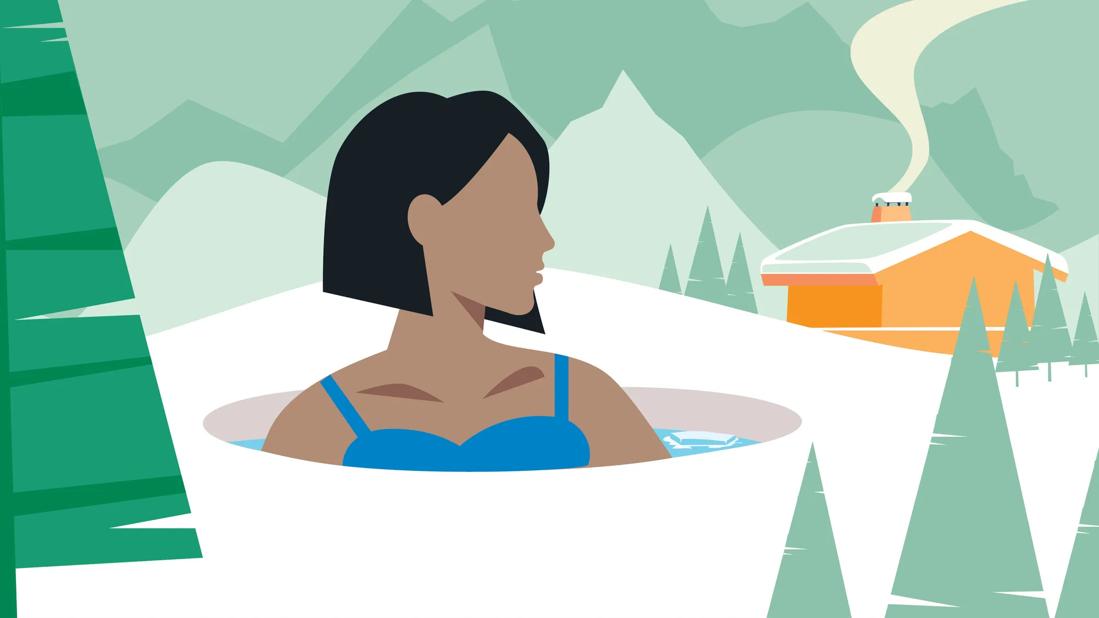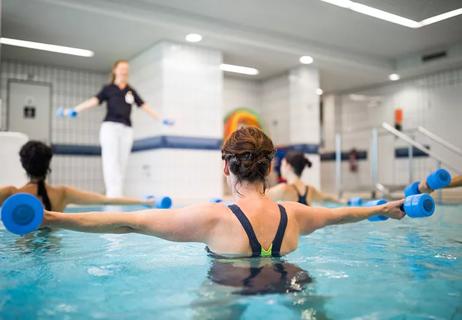If you don’t have an underlying condition, cold plunges might help ease sore muscles, decrease inflammation and even heighten your focus

Have you ever watched behind-the-scenes clips of your favorite sport and seen athletes lowering themselves into big tubs of frigid water after a big game? That’s called a cold plunge, also known as cold therapy or cold-water immersion. It’s basically the practice of taking an ice bath after physical activity.
Advertisement
Cleveland Clinic is a non-profit academic medical center. Advertising on our site helps support our mission. We do not endorse non-Cleveland Clinic products or services. Policy
And you may have heard that folks are starting to do cold plunges at home — either by taking a cold shower or filling their bathtub with ice cubes. But are there any health benefits of this quick and cold dip? And what about risks?
Sports medicine physician Dominic King, DO, explains how to safely take an ice bath and what benefits it can provide your body after a big workout.
A cold plunge is exactly what it sounds like: A brief dip into an ice bath. And an ice bath is exactly what it sounds like: A very, very cold bath.
But unlike the long, relaxing baths you take for self-care purposes, cold plunges are quick, therapeutic dips in ice water. Brrr!
“You can create an ice bath by filling a bathtub halfway with cold water and then adding three large bags of commercial ice,” Dr. King says. “Or use a smaller container to focus on a smaller part of the body, such as the elbow.” Collapsible cold plunge tubs are sold online as well.
You can also do a cold plunge at home without ice. Just fill your bath with water that’s no colder than about 53 degrees Fahrenheit (11.6 degrees Celsius). But if you’re new to cold plunges, Dr. King recommends starting much warmer, at about 68 F (20 C). But don’t be fooled — that’s still pretty darn cold for a bath!
Advertisement
It’s best to keep it quick, starting with three minutes and maxing out at five. “Start low and go slow,” Dr. King advises. “Don’t go too cold and don’t go for more than five minutes, just to make sure you can tolerate it.”
It’s generally recommended not to go below 40 F (around 4 C). You can check this by using a thermometer. Here’s what Dr. King recommends depending on your experience level of cold plunges:
Also, beginners may start with shorter durations, around one to two minutes, and gradually increase as your body adapts. It’s important to listen to your body and exit if you experience discomfort beyond the usual cold sensation.
It’s also good to try sauna therapy for about 15 to 30 minutes after a cold plunge, if you can, to help level out your body temperature.
As long as you’re in good health and don’t have any underlying conditions (more on that in a moment), cold plunges may bring some relief to your sore muscles, improve circulation and even help with sleep.
“There’s no doubt that some people get great relief from using ice baths,” Dr. King shares. “Some people get physical, mental and functional benefits from this kind of cold therapy.”
A small 2017 study showed that ice baths may not be as beneficial as once thought, but many medical professionals — especially those who work with serious athletes — still consider them useful. And a 2021 study of college soccer players showed that cold water immersion therapy promotes basic post-sport recovery.
Here are some of the benefits:
This one is pretty simple: After a hard workout, ice baths feel good. The cold water constricts your blood vessels, which slows blood flow and relieves some of that swelling and soreness you feel in your muscles after a long run or a hard-fought game.
But again, be sure you’re only easing post-workout aches and not actual pain. If you have to push through pain during exercise, there may be an underlying injury. Don’t cover up that pain with cold. “You may be delaying appropriate healing,” Dr. King warns.
If you’ve just worked yourself into a sweat, it follows that an icy dip is a quick way to cool down. When your body is all fired up from a workout, that cold water brings your core temperature back down in a flash.
Advertisement
Remember: Staying in an ice bath too long can lower your core body temp too much, which is also risky. So, don’t go beyond that five-minute limit.
“In sports medicine, ice baths are used for marathon runners and others who are experiencing heat injuries,” Dr. King explains. “We use it as an emergency treatment in the field to bring down their core temperature.”
Honestly, you may just like a cold plunge now and then, especially if you find that the jolt of cold helps snap your brain into focus. “Some people feel that it’s a very helpful mental meditation for them,” Dr. King says.
This benefit is mostly anecdotal and not proven by research, but Dr. King says he’s heard some mention this benefit.
“Some people say it helps them sleep much better and that they feel less fatigue overall,” he reports.
Cold water constricts your blood vessels, which can help with the swelling related to inflammation.
“Some patients who have swelling and inflammation find great relief from soaking in an ice bath,” Dr. King says.
He notes, though, that other people find that works better at reducing their inflammation — so it’s really a matter of figuring out what feels best for your body.
Before you take an ice bath, it’s important to know whether it’s safe for you. Check with your doctor beforehand, as cold plunges can have negative and potentially dangerous effects on people who have medical conditions like:
Advertisement
And even without an underlying condition, here are some risks you should know about before trying a cold plunge:
Prolonged exposure to cold water can lower your core body temperature, leading to hypothermia. This occurs when your body loses heat faster than it can produce it, causing shivering, confusion and, in extreme cases, unconsciousness.
Repeated or overly long cold plunges may cause frostbite or skin damage in extreme cases, especially if you’re exposed to near-freezing water temperatures.
Cold water can trigger rapid, uncontrolled breathing (hyperventilation). This can be dangerous if it leads to dizziness or fainting, especially while in the water.
Cold water causes your blood vessels to constrict, which raises your blood pressure and forces your heart to work harder. According to the American Heart Association, cold plunging can cause a sudden increase in breathing, heart rate and blood pressure. This can be dangerous for people with heart conditions, hypertension or those at risk for stroke.
Extended exposure to cold water can lead to numbness and reduced motor control, making it difficult to exit the water safely. In extreme cases, it can result in cold-induced muscle cramps.
Advertisement
A cold plunge may have certain benefits (especially after a workout) but it shouldn’t be used as a replacement for medical care. And while there are benefits, prolonged exposure can lead to hypothermia or other risks, so moderation is key. Always consult a healthcare professional if you’re unsure about your limits.
And while ice baths can ease your aches and pains, they aren’t the right choice if you’re dealing with something more pressing, like a fracture, a tendon or ligament tear, or another injury.
If you’re not sure, your provider can help you assess whether you’re dealing with an underlying condition. And in general, keep it short and sweet when trying a cold plunge for any reason. Just a dip and that’s it!
Learn more about our editorial process.
Advertisement

Water therapy can provide relief from pain

Prescription oral antivirals are your best bet, but OTC creams can help, too

Weightlifting and other types of resistance training bring many health benefits

Plus, ways to keep your bones healthy and strong!

These red, raised bites often show up in a zigzag pattern on areas of your skin that come into contact with bedding

Bone health starts with proper nutrition, exercise and healthy lifestyle choices

Some things you find in your house have antifungal properties — but that doesn’t mean they’ll clear your toenail fungus

Home remedies are unlikely to cure your contagious foot fungus — and they might even make it worse

If you’re feeling short of breath, sleep can be tough — propping yourself up or sleeping on your side may help

If you fear the unknown or find yourself needing reassurance often, you may identify with this attachment style

If you’re looking to boost your gut health, it’s better to get fiber from whole foods